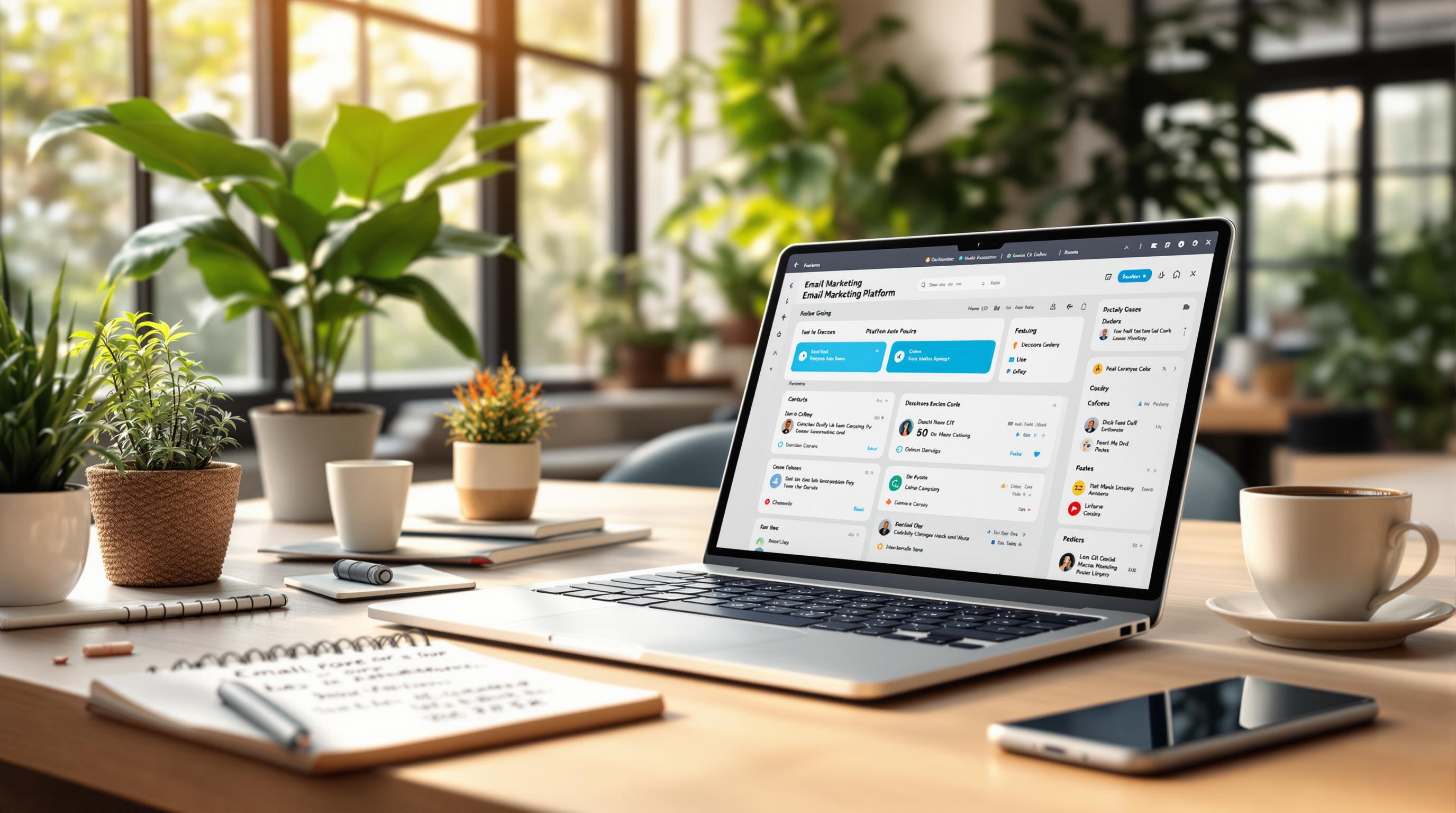In the competitive SaaS world, keeping users engaged is crucial to reducing churn and boosting growth. Re-engagement emails are a powerful way to win back inactive users by reminding them of your platform's value. Here’s a quick overview of 10 effective email templates you can use:
- Welcome Back Email: Simple and personalized to remind users what they’re missing.
- New Features Update: Show off recent improvements and how they benefit the user.
- Special Offer Email: Provide time-sensitive incentives like discounts or bonuses.
- Custom Usage Suggestions: Highlight underused features based on user activity.
- Quick Survey Email: Ask why they left and what could bring them back.
- Benefits Reminder Email: Reinforce the platform’s core advantages.
- Account Progress Update: Showcase user achievements and next steps.
- Last Chance Notice: Create urgency before account deactivation.
- Tips and Guides Email: Offer practical advice to improve their experience.
- Challenge Participation Email: Engage users with goal-oriented activities and rewards.
These templates can help you reconnect with users, increase retention, and gain valuable insights for future strategies. Let’s dive into the details of each approach.
📧 Re-engagement Email Hacks: 5 Free Templates to Win ...
1. Simple Welcome Back Email
This email template is designed to reconnect with users who have been inactive for a while. It’s a straightforward way to remind them of what they’re missing and encourage them to return to your service. Below is a breakdown of how to structure it effectively.
Key Elements:
- Clear subject line that grabs attention
- Brief reminder of the service's benefits
- One prominent call-to-action (CTA) button
- References to past usage or activity
Subject Line Ideas:
- "We Missed You!"
- "Ready to pick up where you left off, [Name]?"
- "Your [Product Name] account misses you"
Email Body Structure:
-
Greeting
Start with a friendly tone and personalize it by addressing the user by name. Mention their last interaction to make it relevant.
Example: "Hi [Name], we noticed you haven’t logged into [Product Name] since [Last Login Date]." -
Value Reminder
Highlight specific actions or milestones they achieved in the past.
Example: "Last time you were here, you [specific action/achievement]. Why not explore even more with [Product Name]?" -
Call-to-Action
Include a single, easy-to-spot button with clear, action-driven text. Examples:- "Resume Your Work"
- "Pick Up Where You Left Off"
- "Log In Now"
Personalization Tips:
- Use the user’s name to make the email feel personal.
- Reference their past activity to show you’re paying attention to their journey.
- Include content tailored to their interests or usage patterns.
- Use dynamic content blocks to ensure the email feels customized for each recipient.
This simple, personalized approach can make a big difference in bringing inactive users back to your platform.
2. New Features Update
Re-engage inactive users by showcasing meaningful updates and improvements to your platform. Highlight what’s new and remind them of the value your product brings.
Key Components:
-
Subject Line Ideas
- "Discover What's New in [Product Name]"
- "We’ve Made Your Workflow Easier"
- "Take a Look at Our Latest Updates"
-
Visuals That Work
Use screenshots, short GIFs (under 10MB), or quick video demos (30-60 seconds) to bring your updates to life. Tie these updates to the user’s past activities for a more personal touch.
Template Structure:
Hi [Name],
We’ve been working hard to improve [Product Name]! Since your last visit on [Date], here’s what’s new:
🚀 [Feature 1 Name]
Feature: [Brief explanation]
Benefit: [How it helps you]
✨ [Feature 2 Name]
Feature: [Brief explanation]
Benefit: [How it helps you]
Excited to try these updates?
[CTA Button: "Explore New Features"]
Personalization Tips:
- Highlight updates tied to the user’s previous activity.
- Mention changes inspired by their feedback.
- Suggest features that align with their workflow.
Best Practices:
- Emphasize Benefits: Explain how each update solves a specific problem.
- Make It Easy to Read: Use clear headers and visual breaks.
- Strong Call-to-Action: Provide a direct link to explore new features.
- Send at the Right Time: Aim for business hours to maximize engagement.
Quick Tips:
- Tailor content to the user’s role and past feature usage.
- Use examples relevant to their industry.
- Adjust your message based on the user’s last active date.
Up next: Learn how to use special offers to bring inactive users back.
3. Special Offer Email
Special offer emails are a great way to reconnect with inactive SaaS users by giving them a limited-time incentive, like a discount or bonus.
Here’s what to include:
- Personalized greeting: Address the user by name to make the email feel tailored.
- Reminder of the offer: Highlight the exclusive deal they’re getting.
- Clear details: Explain the time-sensitive offer in simple terms.
- Call-to-action: Encourage them to act quickly before the deal ends.
Timing is everything - use behavioral triggers to send these emails when they’re most likely to grab attention.
4. Custom Usage Suggestions
Custom usage suggestion emails help re-engage users by highlighting features they haven't fully explored, based on their past activity. These emails provide targeted, actionable tips to enhance their experience.
Here’s how to create an effective custom usage suggestions email:
- Personalize with data: Analyze user activity to find underused features that fit their workflow.
- Show the value: Clearly explain how these features can address challenges or improve their processes.
- Use visuals: Add screenshots or GIFs to demonstrate how the features work.
- Offer clear steps: Include straightforward instructions to help users implement the suggestions.
Email Template Structure
| Email Component | Content Focus | Purpose |
|---|---|---|
| Subject Line | Feature benefit | Emphasize value (e.g., "Boost Your Workflow with These Tips") |
| Opening | Usage context | Reference the user's recent activity or feature use |
| Main Content | 2-3 targeted suggestions | Align recommendations with their behavior |
| Call-to-Action | Single clear action | Provide a direct link to try the top suggestion |
Timing and Follow-Ups
- Send the email 14-30 days after noticing reduced activity.
- If unopened, follow up with a reminder 72 hours later.
For example, if a user frequently uses task management tools on your platform, suggest automation features or integrations to make their workflow smoother.
Pro Tip: Add a "Was this helpful?" button for quick feedback. This not only improves future recommendations but also shows users you're invested in their success.
Next, we’ll look at how surveys can help refine user engagement strategies.
5. Quick Survey Email
Quick survey emails can help uncover why users have stopped engaging and what might bring them back. By asking a few focused questions, you can gather useful feedback to improve your platform.
Key Survey Components
| Component | Description | Example Question |
|---|---|---|
| Usage Frequency | Learn about past usage patterns | "How often did you use our platform?" |
| Exit Reason | Find out why users stopped engaging | "What's the main reason you stopped using our service?" |
| Improvement Areas | Identify features or updates users want | "Which features would make you consider returning?" |
| Return Incentive | Understand what might bring users back | "What would encourage you to give us another try?" |
Next, we'll look at how benefits reminder emails can help re-engage users effectively.
sbb-itb-6e7333f
6. Benefits Reminder Email
When crafting benefits reminder emails, the key is to focus on what matters most to your audience. These emails should highlight the core advantages users might have overlooked or forgotten.
Key Elements of a Benefits Email
Here’s a simple guide to structuring your email effectively:
| Component | Purpose | Example Copy |
|---|---|---|
| Value Statement | Emphasize the main advantage | "Streamline your processes and save time." |
| Success Metrics | Show measurable improvements | "Users report faster project completion rates." |
How to Write a Benefits Reminder
Keep these points in mind:
- Lead with Value: Start with your strongest benefit, backed by specific examples or data.
- Make It Personal: Reference the user’s past activity or engagement to make the email feel relevant.
- Encourage Action: Include a clear call-to-action, whether it’s a button or a direct link, and make it easy to follow through.
Examples of Benefits Messaging
Organize the benefits by their level of impact to make them more compelling:
| Priority | Benefit Type | Example Messaging |
|---|---|---|
| Primary | Time Savings | "Automate repetitive tasks and free up hours every week." |
| Secondary | Cost Reduction | "Cut operational expenses and improve efficiency." |
| Tertiary | Collaboration | "Easily share and collaborate on files across teams." |
When to Send Benefits Emails
Timing is everything. Send these emails:
- After users have been inactive for a while.
- Following major updates or new features.
- After attempts to engage users haven’t worked.
7. Account Progress Update
Progress updates motivate users by highlighting their achievements and outlining clear next steps. These updates help users see their progress and encourage further engagement.
Key Metrics to Include
Focus your updates on these important metrics:
| Metric Type | What to Show | Example Visualization |
|---|---|---|
| Usage Statistics | Active days or features used | "You've used our platform for 45 days" |
| Task Completion | Projects or goals completed | "Completed 12 out of 15 onboarding steps" |
| Resource Utilization | Storage or team usage | "Currently using 75% of available storage" |
Personalizing Progress Updates
Make your updates more engaging by tailoring them to individual user activity:
- Activity Milestones: Highlight accomplishments like "You've automated 50 workflows this quarter."
- Time-Based Comparisons: Show recent progress to encourage timely action.
- Team Impact: If relevant, share metrics that reflect team collaboration or group achievements.
Actionable Next Steps
Provide clear next steps to guide users toward maximizing their experience:
| Current Level | Suggested Action | Benefit |
|---|---|---|
| Basic Usage | Try advanced features | Gain access to automation tools |
| Regular User | Explore integrations | Simplify and streamline workflows |
| Power User | Join the beta program | Get early access to new features |
Writing Tips for Progress Updates
- Start by celebrating user achievements.
- Use visuals like progress bars or charts to make updates more engaging.
- Compare current progress to potential outcomes to illustrate growth opportunities.
Timing Your Progress Updates
Sending updates at the right time can boost engagement. Consider these moments:
- After completing their first major project.
- Upon reaching 30 days of platform usage.
- If they haven’t logged in for two weeks.
- When they approach a key usage milestone.
8. Last Chance Notice
A well-crafted last chance notice combines urgency with a professional tone to encourage users to take action.
Key Elements to Include
| Element | Purpose | Example Text |
|---|---|---|
| Clear Timeline | Specify the deadline | "Deactivation on April 25, 2025" |
| Value Reminder | Emphasize what's at stake | "Access to your 15 saved workflows and 3 team dashboards" |
| Action Steps | Simplify the process | "Click below to reactivate" |
| Support Options | Provide assistance options | "Book a call with our success team" |
Setting the Right Tone
Focus on what the user stands to lose, but avoid harsh or threatening language. Instead, use a supportive tone, like:
"We noticed you haven't logged in recently and want to ensure you don't lose access to your valuable data."
Adding a Personal Touch
Make the notice more engaging by including:
- Highlights of their recent account activity
- Features they’ve used frequently
- Tailored incentives for reactivation
Best Timing for Notices
To maximize effectiveness, send reminders at these intervals:
- 14 days before deactivation
- 7 days before deactivation
- 48 hours before deactivation
Flexible Recovery Options
Provide users with multiple ways to reactivate their account, such as:
- A one-click reactivation link
- Scheduling a product tour
- Offering an account pause option
- Direct access to customer support
Next, learn how tips and guides can play a role in re-engaging your audience.
9. Tips and Guides Email
Tips and guides emails are a great way to help inactive users reconnect with your SaaS platform. By sharing practical advice and useful insights, you can remind users of the value your service brings and encourage them to dive back in.
Content Structure
Here’s how you can structure your email for maximum impact:
| Section | Purpose | Example Content |
|---|---|---|
| Subject Line | Grab attention and spark interest | "Unlock Hidden Features for a Smoother Experience" |
| Value Statement | Emphasize immediate benefits | "Discover actionable insights from our expert-written guides" |
| Main Tips | Provide actionable advice | "Step-by-step shortcuts to enhance your workflow" |
| Visual Elements | Make instructions easy to follow | "Clear screenshots or short tutorial clips" |
| Call-to-Action | Encourage user engagement | "Read More Tips" or "Read the Full Guide" |
Personalization Strategy
Customize your emails based on the user’s past interactions with your platform. For example:
- If a user frequently uses project tools, share tips about advanced automation features.
- If they focus on reporting, send advice on improving data visualization.
- For users who rely on collaboration tools, highlight ways to boost team efficiency.
Content Categories
To make your emails more engaging, focus on these areas:
- Efficiency Boosters: Share time-saving shortcuts and workflows to help users streamline their tasks. For instance, show how automating repetitive processes can free up time.
- Problem Solvers: Address common pain points with easy-to-follow solutions. For example, guide users on simplifying project tracking by consolidating deadlines.
- Feature Highlights: Introduce lesser-known features that align with user needs, like smart filters to organize tasks more effectively.
Using these strategies, you can create emails that not only re-engage users but also encourage them to explore your platform further.
10. Challenge Participation Email
Challenge participation emails are a great way to re-engage inactive users by inviting them to take part in a goal-oriented activity. These emails encourage users to interact with your platform while working toward a specific goal.
Key Components of a Challenge
| Component | Description | Example |
|---|---|---|
| Challenge Goal | A clear, achievable objective | "Complete 5 project automations in 7 days" |
| Time Frame | A defined duration | "Two-week sprint" or "30-day challenge" |
| Reward | A tangible incentive | "3 months premium access or a custom dashboard template" |
| Progress Tracking | A way to measure progress | "Daily progress bar" or "Achievement badges" |
| Community Element | Social engagement features | "Leaderboard updates" or "Team rankings" |
Types of Challenges for SaaS Platforms
Design challenges that align with your platform's features and user goals. Here are some examples:
- Productivity Sprints: Short-term challenges that focus on completing tasks or improving efficiency. For instance, a "5-Day Workflow Challenge" could guide users through setting up five automated workflows.
- Feature Exploration: Encourage users to discover and master your platform's advanced tools. An example could be the "Power User Challenge", where participants unlock achievements by using features like custom integrations or detailed reporting.
- Team Collaboration: Create challenges that boost teamwork and engagement. For example, a "Team Efficiency Challenge" could have departments competing to improve project completion rates using your collaboration tools.
Email Template Structure
Subject Line Ideas
- "Join the [Platform Name] Power User Challenge - Win 6 Months Free"
- "Ready to Level Up? 7-Day Productivity Challenge Starts Monday"
- "Compete, Learn, and Win: Master [Feature] in 14 Days"
What to Include in the Email
- A clear description of the challenge
- Benefits of participating
- Simple and clear rules
- How progress will be measured
- Details on the rewards
Tips to Boost Engagement
- Add a countdown timer to create urgency.
- Show social proof, like "Over 500 participants have already joined."
- Include quick-start resources to make it easy for users to participate.
- Provide tools like progress trackers or templates.
- Offer early-bird bonuses for users who sign up right away.
This strategy is another effective way to bring inactive users back to your SaaS platform and keep them engaged.
Conclusion
Re-engagement campaigns play a key role in driving SaaS growth. The ten templates outlined above provide a range of approaches to reconnect with inactive users effectively.
Key Implementation Strategies
| Strategy | Purpose | Impact |
|---|---|---|
| Segmentation | Focus on users based on activity and usage trends | Improves targeting for better engagement |
| Personalization | Customize content to match user behavior | Makes emails more relevant and actionable |
| A/B Testing | Test subject lines, content, and calls-to-action | Boosts email performance and engagement |
| Automation | Trigger emails based on specific user actions | Simplifies campaign management |
Combine these strategies with a well-planned re-engagement sequence for the best outcomes.
Best Practices for Success
Stay consistent in your communication while respecting user preferences. Use relevant data to personalize emails with tailored recommendations and offers.
Here’s an example of a focused multi-step sequence:
- Initial Re-engagement: Send a friendly reminder about your platform's key features and recent updates.
- Value Reinforcement: Highlight the benefits and features that match the user's past behavior.
- Final Decision Point: Provide a clear call-to-action, such as renewing their subscription or updating their account.


